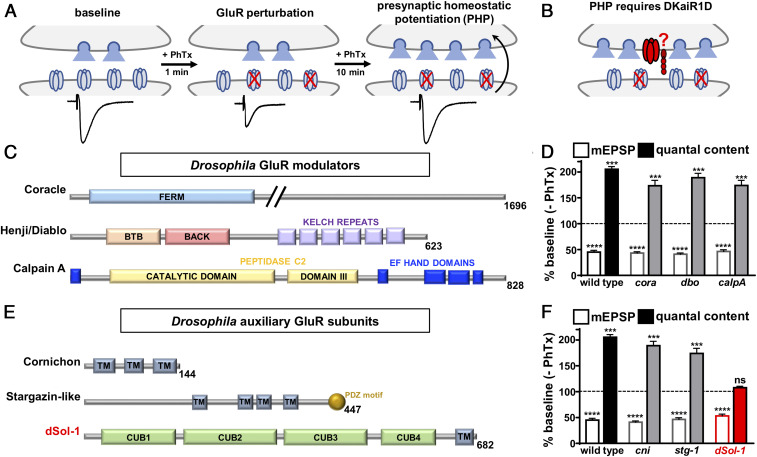Fig. 1.
Candidate screen of GluR modulators and auxiliary subunits identifies dSol-1 to be necessary for PHP. (A) Schematic illustrating presynaptic homeostatic potentiation at the Drosophila NMJ. Application of the postsynaptic glutamate receptor antagonist philanthotoxin-433 to the larval NMJ initially causes an ∼50% reduction in EPSC amplitude. After 10 min, EPSC amplitudes return to baseline values due to a homeostatic enhancement in presynaptic neurotransmitter release (quantal content). (B) Schematic showing the presynaptic kainate receptor DKaiR1D (noted in red) functions as an autoreceptor near release sites to enhance neurotransmitter release following PhTx application. The putative auxiliary subunit (also in red) that may function with DKaiR1D is unknown. (C) The domain structures of known proteins in Drosophila that modulate GluR levels and trafficking are shown. (D) Quantification of average mEPSP amplitude and quantal content values in mutations of coracle (cora: w;coraMI00820), diablo/henji (dbo: w;dbo8), and calpain A (calpA: w;calpAKG13868) after PhTx treatment normalized to baseline values (−PhTx). A reduction in mEPSP amplitude but concomitant increase in quantal content demonstrates PHP is expressed in these genotypes. (E) The domain structure of putative auxiliary GluR subunits in Drosophila. TM, transmembrane domain. (F) Quantification of average mEPSP amplitude and quantal content values in putative mutations or RNA interference lines of cornichon (cni: OK6-Gal4/+;UAS-cornichon-RNAi/+), stargazin-like (stg-1: stg-1EY06948), and dSol-1 (dSol-1: w;dSol-1MI14035) after PhTx application normalized to baseline values (−PhTx). dSol-1 mutants fail to increase presynaptic release (quantal content) following PhTx application. Error bars indicate ±SEM. ***P < 0.001, ****P < 0.0001; ns, not significant. Details of the mutations and RNAi lines screened, their source, and absolute values of electrophysiology data have been summarized in SI Appendix, Table S1.

